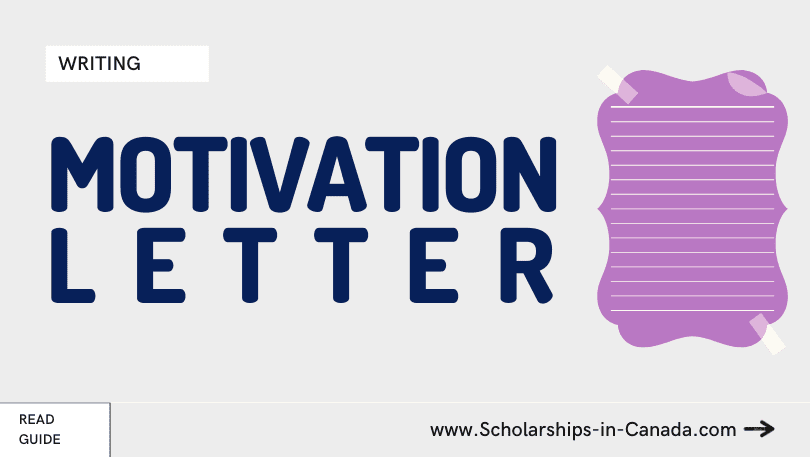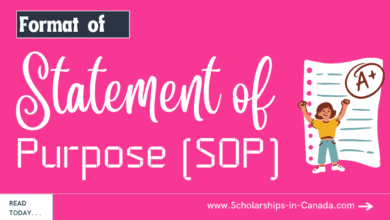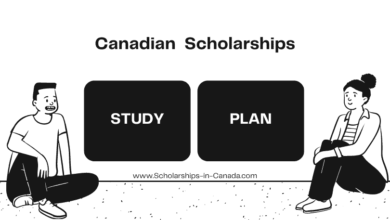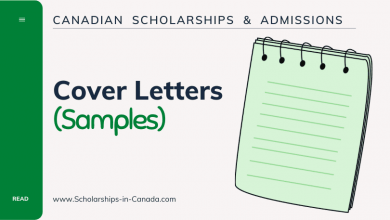Perfect Motivation Letter for Canadian University Applications

When you’re applying for a Canadian Scholarship, one of the best chances you get to express yourself, your passion, and your dedication to the scholarship committee is through a motivation letter.
What is a Motivation Letter?
A motivation letter is a part of your scholarship application that is essentially equivalent to a cover letter in a job application. A motivation letter is a document in which you use your achievements, skills, and strengths to introduce yourself to the admissions office and convince them to accept your scholarship application.
When there are thousands of other students applying for the same scholarship, a motivation letter is a perfect opportunity to express who you are as a person, your interests, future goals, and your passion for the field you are pursuing on a very personal level.
However, just as any other document required in scholarship applications, this is an academic document, written to certain authoritative figures, and hence, there is a certain format that you need to follow while writing it.
So let’s get into it!
Format for Writing a Motivation Letter for a Canadian Scholarship Application:
- Title of the letter- Letter of motivation for the scholarship you’re applying to
- Your full name and contact details (Phone and email must be included. Social networks are optional.)
- Name of the university you are applying to with its address
- The date
- Dear Sir/ Madam (You can address the person directly if you know their name; this is important because addressing someone by name will immediately grasp their attention)
- Introduction
- Body of letter
- Concluding paragraph (with acknowledgment and summary of the body)
- Best regards and Signature
Follow the given standard formatting to make your letter eye-friendly at first glance, unless it has been specified otherwise:
- Left-aligned
- One-inch page margins
- 1 or 1.15 line spacing
- 12 font size in Times New Roman or Arial
- Double-spacing between paragraphs
How to Write a Motivation Letter for a Canadian Scholarship Application?
#1 Research Objectives an Novelty:
The first step is to do your research about the university you will be attending and figure out what the scholarship provider is most interested in when scanning through the applications of thousands of candidates. You can do this by going through the university’s website and by talking to alumni if possible.
Do the research for your specific field and university so while writing your application; you can focus more on experiences, skills, and achievements that meet their requirements. For example, if it’s a university that prides itself in creating future leaders, they will be more interested in your experiences that showcase your leadership and communication skills alongside your academics.
Additionally, by doing your research before applying, you’ll be able to determine whether you even meet all the requirements for the university or not.
#2 Develop an Outline:
Now that you’ve done your research and know which points you want to focus on, the next step is to create an outline of how you are going to structure your letter. The format given above gives you a basic outline that you need to follow. From there onward you just need to decide whether you want to follow a 5 paragraph structure or a 7 paragraph structure. In the first one, your body will include only 3 paragraphs whereas, in the second one, it can include up to 5.
Next, briefly jot down the points you need to discuss in each of the paragraphs. Remember that a motivation letter is a very quick read (about 20 seconds) so you only have about a page or so to get your point across. Include only the most relevant qualifications and focus on experiences that show your passion for the field.
#3 Writing the introduction:
The introduction gives you the opportunity to capture the reader’s attention and engage their curiosity about what you might have to offer as a potential student in their university.
Start off the introduction by introducing yourself, your education level, and the program that you have applied to. Then, grasp their attention by mentioning something that instantly shows your passion and dedication towards the field, and follows it up with a big achievement that fits the scholarship.
The goal is to get them interested in you, and by charming them with your achievements and passionate statements, you can expand on the reasons why they should accept you in the body of your letter.
#4 Writing the body of the letter:
Ideally, most people usually divide up the body of their letter into 3 paragraphs. In this portion of the letter, you will mainly talk about what makes you the best possible candidate for the scholarship, what your academic and future goals are, and express your passion for the scholarship program.
In the first paragraph of the body, you’re going to mention your academic standing, achievements, relevant volunteer work, and acquired skills. Just mentioning your skills isn’t enough; you get bonus points from explaining how you acquired certain skills rather than just giving a generic answer.
Remember, anyone can say that they have had a 4.0 GPA and have certain qualities, but the more examples you give that back up your claims, the better chance you have of getting your application approved. The goal is to make it unique and help you stand out as an ideal candidate.
In the second paragraph of the body, you will talk about why you want the scholarship. Again, to strengthen your argument, this is the paragraph where you express your passion for the scholarship program, your interest in the field, and how you stand to benefit from the scholarship. This is where all the research you did about the university and the program comes in handy because you can go more into specifics, like talking about which professors you’re excited to learn from, or which facility you’re more excited to utilize from the university.
Since you’re applying to Canada, it’ll be helpful to include solid reasons for why you want to study in Canada and what characteristics you possess that will help you while you’re abroad.
Then, in the third paragraph of the body, you will talk about future plans. What do you plan on doing with your degree? How will it be beneficial for your future and how will you utilize it to create an impact in your field?
#5 Writing the conclusion and signing off:
In your conclusion, simply summarize the main points that show your interest and prove yourself as a worthy candidate. Then, you can also ask for a personal interview if possible to further discuss your application (however this will most likely only be relevant if you are applying for a research grant and want to discuss your ideas in detail).
Lastly, give your regards, write your full name, sign the letter off, and you’re done!
Tips to keep in mind when Writing a Motivation Letter:
- Keep your letter 1 page long with a word limit of around 500- 1000.
- Use logical reasoning and persuasive language to convince the scholarship committee but don’t make it sound like you’re bragging or begging for the scholarship.
- Use simple language, and keep your sentences short, rather than forming complex sentences with a lot of technical wording that the reader might not necessarily be familiar with. Stay professional and do not use slang language in your letter either
- Be personal in your letter. This one is especially important. The motivation letter is a chance for you to show the scholarship committee who you are, so instead of writing your letter based entirely on a template online, try to make it as unique and personal as possible. The committee will be reading thousands of letters, so focus more on writing things that will make you stand out from the rest of the competition.
- Remember to focus on your strengths when writing the letter rather than bringing up your weak points and challenges you think you might face in the program. Remember, they need to know why you deserve the scholarship, not a reason to dismiss your application!
- Lastly, once you have written your letter and proofread it, it’s always a good idea to have someone with a good grasp of the English language read through your letter and make sure you don’t have any grammatical errors.
Good luck!
Hopefully, now you know how to structure a motivation letter and all the points that you need to keep in mind to write the most impressive motivation letter you can. Feel free to refer back to the format and tips mentioned to make sure that you are not missing anything out while writing yours and good luck!



